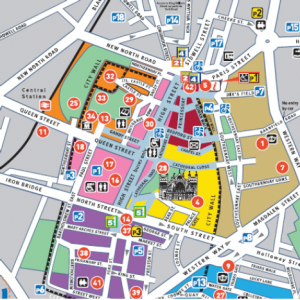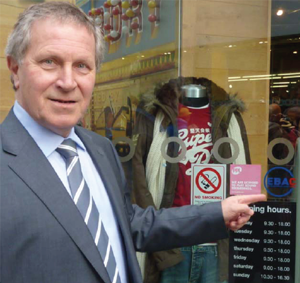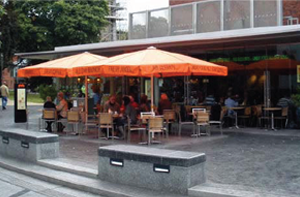How NEXEDGE Keeps Exeter City Centre Safe From Crime
 “Our aim is to ensure Exeter City Centre is as safe, welcoming and vibrant at midnight as it is at eight o’clock in the morning”.
“Our aim is to ensure Exeter City Centre is as safe, welcoming and vibrant at midnight as it is at eight o’clock in the morning”.
Anthony Couch, Exeter Business Crime Manager and architect of the Exeter Business Against Crime (EBAC) initiative talks to us about how a NEXEDGE® trunked digital two way radio network helps keep his city centre safe.
Since its introduction by Exeter City Centre Management Partnership in 2005 as part of the Association of Business Crime Partnerships programme, demand to join the Exeter Business Against Crime (EBAC) initiative has grown consistently to include shops, pubs, restaurants, car parks, police and even street chaplains operating in the city centre.
With a resident population of around 120,000, a top 10 university, excellent road, rail and air transport links and regional investment, Exeter is one of the top ten most profitable locations for a business to be based.
The bustling, historic city centre offers over 1.4 million sq ft of retail floor space, the bulk of which is situated along and immediately off the High Street with its extensions onto Fore and Sidwell Streets and the areas immediately around them within the city’s Roman walls. In addition, there is around 3 million sq ft of office accommodation which in combination with retail, cafes, restaurants and bars provide over 20,000 city centre jobs.
With all that Exeter offers, it’s not surprising to read that The Telegraph in an article dated 5th December 2011, ranks Exeter third in the Top 10 places to buy a property in the UK.
 Anthony Couch, Exeter Business Crime Manager is a former RAF and Commercial pilot who joined Exeter City Centre Management Partnership in 2005 to finalise the planning and implementation of the EBAC initiative. One of his principal tasks in creating the infrastructure for EBAC was to establish a robust security and public safety strategy, supported by a reliable communications network, incorporating efficient processes and protocol, he comments: “It’s my job to ensure the safety of workers, shoppers and visitors and to work with businesses and the police to keep the city centre free from crime and anti-social behaviour”. By the time the EBAC initiative was launched in 2006, PMR Products of Chepstow had installed a KENWOOD trunked analogue radio network, linked to their own SafetyNet radio management programme, to cover the initial EBAC geographic area.
Anthony Couch, Exeter Business Crime Manager is a former RAF and Commercial pilot who joined Exeter City Centre Management Partnership in 2005 to finalise the planning and implementation of the EBAC initiative. One of his principal tasks in creating the infrastructure for EBAC was to establish a robust security and public safety strategy, supported by a reliable communications network, incorporating efficient processes and protocol, he comments: “It’s my job to ensure the safety of workers, shoppers and visitors and to work with businesses and the police to keep the city centre free from crime and anti-social behaviour”. By the time the EBAC initiative was launched in 2006, PMR Products of Chepstow had installed a KENWOOD trunked analogue radio network, linked to their own SafetyNet radio management programme, to cover the initial EBAC geographic area.
Intelligence, Awareness and Exclusion
Anthony continues: “The EBAC strategy for crime reduction is built on three main themes – Intelligence, Awareness and Exclusion. Let’s start with Intelligence – we now have over 250 NEXEDGE® hand portable digital radios deployed with members across the city centre at all key locations. Their operators, whether store or bar staff or security teams provide our control centre with a constant stream of on the ground intelligence, identifying shoplifters, suspicious packages, threatening behaviour and those disrupting the enjoyment of the city centre.
The next theme of Awareness is where we share the pooled intelligence with our members and extended stakeholders including the Police.
 We publish and distribute an album of known offenders and suspects to our members at our bimonthly meetings – this serves to keep members engaged in the initiative, but more important it allows them to alert each other by radio if known offenders or suspects are seen in the area and to keep vigilant.
We publish and distribute an album of known offenders and suspects to our members at our bimonthly meetings – this serves to keep members engaged in the initiative, but more important it allows them to alert each other by radio if known offenders or suspects are seen in the area and to keep vigilant.
Our members work with each other and deal with many incidents themselves in terms of crime prevention and reduction, only involving the police in cases where additional assistance or arrest is necessary.
And onto our final theme, Exclusion. When we have captured evidence of repeated attempts to shoplift or to carry out anti-social behaviour, we take the case to court and request an exclusion order, banning the individuals from certain shops or city centre areas, if the individual persists in breaking the conditions of their exclusion order, we would seek to have an ASBO placed on the individual.”
The EBAC strategy certainly seems to be working with numerous exclusion orders and ASBOs effected, but the real indicators of success can be seen in the growing numbers of visitors to the city’s shopping areas, restaurants and bars and the inbound investment in the city centre including the £200 million, 530,000 sq ft Princesshay shopping centre opened in 2007.
The scheme represented the biggest single investment in regeneration in Exeter’s history and brought together Land Securities in partnership with Exeter City Council in a vibrant city centre scheme which has further enhanced its reputation as the regions capital city.
 Of course in terms of sustainability, it’s vital to further capitalise on the city’s rich cultural heritage, transport links and commercial opportunities in equal measure and the EBAC strategy and the city’s master plan have delivered this successfully over the past decade and with a new 67,000 sq ft John Lewis due to open in late 2012, creating 300 new jobs in the city centre, it looks to continue into the future in spite of global economic uncertainties.
Of course in terms of sustainability, it’s vital to further capitalise on the city’s rich cultural heritage, transport links and commercial opportunities in equal measure and the EBAC strategy and the city’s master plan have delivered this successfully over the past decade and with a new 67,000 sq ft John Lewis due to open in late 2012, creating 300 new jobs in the city centre, it looks to continue into the future in spite of global economic uncertainties.
It might all appear to be a bed of roses in the story of the city’s sustained growth, but on Thursday 22 May 2008, an unprecedented act of terrorism took place in Exeter that would change the way UK city centres manage their contingency planning and disaster recovery forever.
At 12:50 on 22 May 2008, Nicky Raymond Reilly (now known as Mohamed Abdulaziz Rashid Saeed-Alim), a 22 year old male from Plymouth attempted to carry out a suicide bomb attack from a toilet in the Giraffe cafe and restaurant in Princesshay.
Fortunately, the attempt failed as the device’s detonator went off without igniting the main charge causing damage to the restaurant, but no injuries to the public except to the perpetrator himself.
Police were immediately called to the scene and evacuated and cordoned off the immediate area. The cordon was originally confined to the Princesshay area, but was later extended to cover the whole of the city centre, from the bottom of High Street to Sidwell Street. A further device was found in the vicinity of the cafe, but was disabled by a bomb disposal team.
At the time of the bombing the first people to respond were members of the EBAC initiative who assisted in evacuating the area, Anthony Couch recollects: “The mobile phone networks were jammed and our only means of coordinating activities and gathering information was by our KENWOOD two-way radio system, linking our CCTV control centre to security personnel on the ground; while we hadn’t planned on an event of this nature, the incident proved to us the extended value of having our EBAC initiative in place, our communications protocol and the capabilities of two way radio in these exceptional situations”.
 Business as usual
Business as usual
The city returned to business the next day with all shops open with the exception of Giraffe cafe. This incident prompted a comprehensive review of the city’s contingency and disaster recovery plan with specific focus on the swift evacuation of large numbers of people to safe areas.
The terrorist threat of 2008 was exceptional, but lessons have been learned and further investment made in the security infrastructure in the city.
Exeter has invested in one of the most comprehensive CCTV operations in the UK which provides coverage of all key points in the city centre. The entire system is fibre optic based and has evolved and grown alongside the regeneration of the city. The Exeter City Council Control Centre is staffed around the clock by experienced operators in a modern and fully equipped control room with radio communications links to EBAC members and direct connections to the emergency services. Richard Radmore is a Senior Controller with more than ten years experience with a trained eye for spotting suspects as they enter the city centre and an instinct for anticipating incidents.
He shares his thoughts on the EBAC initiative: “There’s no doubt EBAC has made a significant and positive difference to the city visitor experience. The initiative has integrated seamlessly with our existing CCTV operation and has given us the means to operate far more effectively in crime prevention and reduction. We have over 130 cameras in the city centre all with overlapping fields of vision to allow us to follow movement without coverage gaps. In many instances, we have been able to work with EBAC members on the ground via the NEXEDGE® radio system to coordinate security measures and to alert them and the police to situations we are monitoring. I would say that while we are able to cover vast areas with our cameras, the EBAC members are the eyes and ears of the city”.
| |
 |
 |
Of the more recent situations to be managed is the collection of 13 tents housing a group calling themselves Occupy Exeter who have set up camp in the grounds of Exeter’s Cathedral, following the ongoing demonstration outside St Paul’s in London, which forced the building to close for the first time since the Blitz.
While these are peaceful protesters who are taking care not to damage the site, they nevertheless pose a challenge to city centre security as other members of the community may not share their views or methods. The cathedral is situated in the heart of the city a short distance from the main shopping areas and is therefore highly visible both day and night.
“Security has of course been stepped-up and working with the police we remain watchful should any incidents arise” comments Anthony Couch as we walk past the scene with Nicola Harget, Business Development Manager at PMR Products.
She commented: “Exeter City’s EBAC initiative was the first of PMR Products clients to upgrade to the NEXEDGE® digital two way radio system. The new system builds on the experience we gained with the KENWOOD analogue system we installed in 2006 along with our SafetyNet radio manager system. The NEXEDGE® digital system provides marked improvements in range, coverage and provides EBAC with the flexibility to incorporate additional users and groups”.
Extended coverage and clarity of digital
Anthony Couch added: “We are very pleased with the performance of the new digital system with its extended coverage and clarity. But what makes it more effective in operational terms is the ability I have to ‘broadcast’ messages to all users or user groups and to have open, group, one to one and emergency channels at my disposal. The hand portable radio units have proven to be durable and the battery life is good”. He continues: “I’m a great fan of PMR Products SafetyNet radio management programme which provides additional security and operational enhancements to our radio network including voice recording and tagging, live status of all radios in use, polling of individual users and the remote stunning and revival of radios”.
EBAC’s three channel NEXEDGE® system provides one general open channel, a second for one-to-one secure communication and texts and the third for communications in and around the Princesshay shopping centre.
| |
 |
The SafetyNet Management system is installated on two control PCs, one in the EBAC management office and the other in the city’s CCTV Control Centre |
| |
|
|
The NEXEDGE® system was fully installed by PMR Products in April 2010 and includes two NXR-800 base repeater units, a further six NXR-800E mobile units, over 240 hand portable radios, some with keypads and two fixed aerials, strategically located to provide maximum coverage of all the main areas covered by the EBAC members.
Exeter’s safe and vibrant city centre